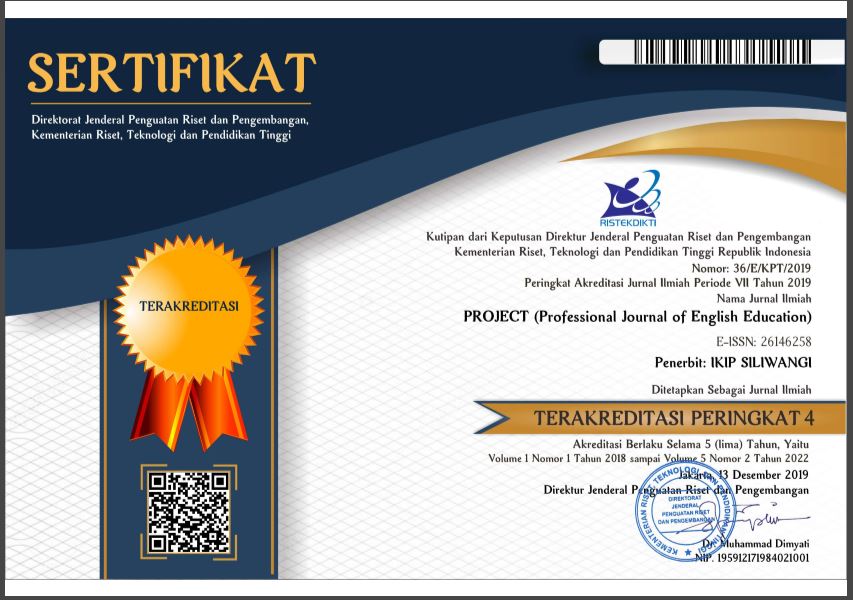STUDENT EMPOWERMENT IN MOBILE-ASSISTED ENGLISH LANGUAGE LEARNING FOR LISTENING SKILL
Abstract
Mobile-Assisted Language Learning (MALL) has become an increasingly important component of teaching and learning in university environments, especially in the context of listening classes and interpreting audio in foreign languages. This study used mixed qualitative and quantitative research methods, including surveys and interviews, to collect data about the use of MALL in listening classes in university settings. The results of this study describe students' perceptions, and voices, and identify the challenges students face when participating in Mobile-Assisted English Learning for listening activities. In the context of a listening class, MALL allows students to practice listening with a diversity of audio sources, including recorded speeches, interviews, and other structured audio materials. This ability can improve their oral comprehension skills and expand their understanding of language variations used in real situations. This research concludes that MALL can be an effective tool for improving students' listening skills in a university environment.
References
Albadry, H. F. A. (2018). Using mobile technology to foster autonomy among language learners (Doctoral dissertation, Newcastle University).
Ardiansyah, A. A., & Nana, N. (2020). Peran mobile learning sebagai inovasi dalam meningkatkan hasil belajar siswa pada pembelajaran di sekolah. Indonesian Journal of Educational Research and Review, 3(1), 47-56.
Cakmak, F. (2019). Mobile learning and mobile assisted language learning in focus. Language and Technology, 1(1), 30-48.
Chun, D., Kern, R., & Smith, B. (2016). Technology in language use, language teaching, and language learning. The Modern Language Journal, 100(S1), 64-80.
Cleary, T. J., & Zimmerman, B. J. (2004). Self‐regulation empowerment program: A school‐based program to enhance self‐regulated and self‐motivated cycles of student learning. Psychology in the Schools, 41(5), 537-550.
Davis, W. S., & Bowles, F. (2018). Empowerment and intrinsic motivation: A self- determination theory approach to language teaching. CSCTFL Report, 15, 1-19.
Gilakjani, A. P., & Sabouri, N. B. (2016). Learners' Listening Comprehension Difficulties in English Language Learning: A Literature Review. English language teaching, 9(6), 123-133.
Gilakjani, A. P., & Ahmadi, M. R. (2011). A study of factors affecting EFL learners' English listening comprehension and the strategies for improvement.
Heil, C. R., Wu, J. S., Lee, J. J., & Schmidt, T. (2016). A review of mobile language learning applications: Trends, challenges, and opportunities. The EuroCALL Review, 24(2), 32-50.
Islam, A. S., & Hasan, M. (2020). The effectiveness of mobile assisted language learning (MALL) on ESL listening skill. NOBEL: Journal of Literature and Language Teaching, 11(2), 188-202.
Hadi, M. S. (2020). Mobile-assisted language learning (MALL) in EFL listening: An Indonesian Perspective. International Journal of Advanced Science and Technology, 29(7), 3838-3845.
Katemba, C. V. (2021). Enhancing vocabulary performance through mobile assisted language learning at a rural school in Indonesia. Acuity: Journal of English Language Pedagogy, Literature and Culture, 6(1), 1-11.
Kavaliauskienė, G. (2008). Podcasting: A tool for improving listening skills. Teaching english with technology, 8(4).
Liubinienė, V. (2009). Developing listening skills in CLI. Kalbų studijos, (15), 89-93.
Mah, A. S. H. (2015). Book Review: Teaching and Learning Second Language Listening: Metacognition in Action.
Wang, C. M., Chiang, M. C., Yang, C. S., & Thai, C. W. (2011). Aided contents supporting service for e-learning systems. International Journal of Innovative Computing, Information and Control, 7(7 A), 4005-4026.
Nurjannah, N., Nurhadi, K., & Tambunan, A. R. S. (2023). Assessing Student Empowerment in Mobile-Assisted Extensive Reading in a University Setting. Qualitative Report, 28(6).
Nuraeni, C., Carolina, I., Supriyatna, A., Widiati, W., & Bahri, S. (2020, November). Mobile-Assisted Language Learning (MALL): Students’ perception and problems towards mobile learning in English language. In Journal of Physics: Conference Series (Vol. 1641, No. 1, p. 012027). IOP Publishing.
Puebla, C., Fievet, T., Tsopanidi, M., & Clahsen, H. (2022). Mobile-assisted language learning in older adults: Chances and challenges. ReCALL, 34(2), 169-184.
Richards, J. C. (2005). Communicative language teaching today. Singapore: SEAMEO Regional Language Centre.
Richards, J. C. (2008). Teaching listening and speaking (Vol. 35, No. 4). Cambridge: Cambridge university press.
Sabet, M. K., & Mahsefat, H. (2012). The impact of authentic listening materials on elementary EFL learners’ listening skills. International Journal of Applied Linguistics and English Literature, 1(4), 216-229.
Saleem, A. N., Noori, N. M., & Ozdamli, F. (2022). Gamification applications in E-learning: A literature review. Technology, Knowledge and Learning, 27(1), 139-159.
Sari, A. W. (2016). Pentingnya Ketrampilan Mendengar dalam Menciptakan Komunikasi yang Efektif. EduTech: Jurnal Ilmu Pendidikan dan Ilmu Sosial, 2(1).
Usman, & Zulfah. (2022). Literasi Digital Dan Mobile (Majdy AmiruddinMuhammad, ed.). parepare: IAIN Parepare Nusantara Press (Anggota IKAPI).
Wang, J., Yu, W. C. W., & Wu, E. (2013). Empowering Mobile Assisted Social E-Learning:" Students' Expectations and Perceptions". World Journal of Education, 3(2), 59-70.
Wardak, M. (2020). Mobile assisted language learning (mall): teacher uses of smartphone applications (apps) to support undergraduate students’ english as a foreign language (efl) vocabulary development. Lancaster University (United Kingdom).
Weaver, C. (1996). Teaching grammar in context. Boynton/Cook Publishers, Inc., 361 Hanover Street, Portsmouth, NH 03801-3912.
Yurko, N., & Styfanyshyn, I. (2020). Listening skills in learning a language: the importance, benefits and means of enhancement. Publishing house «European Scientific Platform», 38-46.
Downloads
Published
Issue
Section
License

This work is licensed under a Creative Commons Attribution-ShareAlike 4.0 International License.




